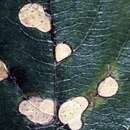fi
nimet breadcrumb-navigoinnissa


Monochaetia is a genus of fungi in the family Sporocadaceae.[2] Species in the genus are typically plant parasites and saprobes, and cause leaf spot diseases on various hosts.[3]
The genus Monochaetia was introduced by Allescher in 1902, it had 23 species originally. Allescher (1902) also designated the type as Monochaetia monochaeta, which has a single apical appendage (Guba 1961; Maharachch. et al. 2014; Senanayake et al. 2015).[4] Steyaert (in 1949) transferred numerous Monochaetia species to Pestalotiopsis or Truncatella. More than 40 species of Monochaetia were recognised by the monograph of Guba (1961). There are 127 Monochaetia epithets in the Index Fungorum (as of 31 March 2022) and most have been transferred to other genera such as Sarcostroma, Seimatosporium and Seiridium (Nag Raj 1993; Maharachch. et al. 2011, 2014, 2016).[5]
As accepted by Species Fungorum;[6]
Monochaetia is a genus of fungi in the family Sporocadaceae. Species in the genus are typically plant parasites and saprobes, and cause leaf spot diseases on various hosts.
The genus Monochaetia was introduced by Allescher in 1902, it had 23 species originally. Allescher (1902) also designated the type as Monochaetia monochaeta, which has a single apical appendage (Guba 1961; Maharachch. et al. 2014; Senanayake et al. 2015). Steyaert (in 1949) transferred numerous Monochaetia species to Pestalotiopsis or Truncatella. More than 40 species of Monochaetia were recognised by the monograph of Guba (1961). There are 127 Monochaetia epithets in the Index Fungorum (as of 31 March 2022) and most have been transferred to other genera such as Sarcostroma, Seimatosporium and Seiridium (Nag Raj 1993; Maharachch. et al. 2011, 2014, 2016).